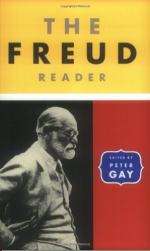
|
| Name: _________________________ | Period: ___________________ |
This test consists of 15 multiple choice questions and 5 short answer questions.
Multiple Choice Questions
1. How many pages is the paper on the subject of the unconscious?
(a) 7.
(b) 9.
(c) 11.
(d) 12.
2. What type of love does Freud say is sometimes the best and most true?
(a) Sexual.
(b) Giving.
(c) Dutiful.
(d) Kind.
3. What does Freud suggest could avoid homosexuality in males?
(a) Having a more present father.
(b) Playing sports with their father.
(c) Having a mean mother.
(d) Watching football.
4. What animal does Freud mention the Jews make an idol out of?
(a) A golden calf.
(b) A hairy buffalo.
(c) A golden fish.
(d) A weak lamb.
5. What does Freud refer to when a person both loves and hates a person, a condition or thing?
(a) Over emotional.
(b) Ambivalence.
(c) Obsessive Compulsive Disorder.
(d) Bi-polar.
6. How does Freud define homosexuality?
(a) Secondary to Totem and Taboo.
(b) As an emotional attitude rather than actual behavior.
(c) The same sex liking each other.
(d) He calls it transference.
7. What play by Shakespeare was mentioned in "Psychoanalysis in Culture"?
(a) King Lear.
(b) Hamlet.
(c) Othello.
(d) Romeo and Juliet.
8. What does Freud say about the totem if it is a pet?
(a) It is treated as a totem animal, not a wild adversary.
(b) It will be sacrificed by its owners.
(c) It is wild.
(d) It is tame.
9. What does Freud say a doctor normally meets in the patient?
(a) Resistance.
(b) Obsessions.
(c) Compulsion.
(d) Neurosis.
10. How does Freud define narcissism?
(a) Disturbing.
(b) When a person is self-obsessed.
(c) When a person loves with oneself.
(d) When healthy self love has been taken too far.
11. What does Freud say is needed to reach superior pleasure in therapy?
(a) An open mind.
(b) Foregoing immediate pleasure.
(c) Being honest.
(d) Trusting his or her therapist.
12. What does Freud call the term when two diverse psychic attributes drive behavior along different lines?
(a) Double mindedness of double consciousness.
(b) Different reasoning.
(c) Spiral of thoughts.
(d) Cycle of psyche.
13. What was Freud's daughter's profession?
(a) She was a therapist.
(b) She was a nurse.
(c) She was a teacher.
(d) She progressed the field of psychology like her father.
14. What other work was being done in the field of psychology at the same time as the "birth trauma"?
(a) Male sexuality.
(b) Sleep apnea.
(c) Female sexuality.
(d) Homosexuality.
15. What does Freud say is a weakness of the philosophy on the unconscious?
(a) High value placed on the conscious, without including the unconsious.
(b) Inability to test the subject.
(c) Inability to prove its findings.
(d) The lack of scientific research on the unconscious.
Short Answer Questions
1. What does Freud claim about the Oedipal complex in relation to human development?
2. What sheer coincidence is mentioned in "Psychoanalysis in Culture" about Freud that relates to competitive jealousy?
3. What is the first rule to the psychoanalytic theory?
4. What does Freud rename the term 'subconscious'?
5. By Freud's research on the libido, what is he not excluding on the topic?
|
This section contains 528 words (approx. 2 pages at 300 words per page) |

|




